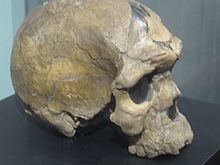Kingdom Animalia Order Primates Family Hominidae Scientific name Homo sapiens idaltu Rank Subspecies | Phylum Chordata Suborder Haplorhini Genus Homo Higher classification Human | |
 | ||
Similar Human, Humans, Homo rhodesiensis, Great apes, Homo cepranensis | ||
Homo sapiens idaltu
Homo sapiens idaltu, also called Herto Man, is the name given to a number of hominid fossils found in 1997 in Herto Bouri, Ethiopia. They date to around 160,000 years ago. "Idaltu" is from a Saho-Afar word and translates to "elder" or "first born".
Contents
As "certain cranial traits are outside the range of modern human variation", paleoanthropologists determined that the finds belong to an extinct subspecies of Homo sapiens who lived in Pleistocene Africa. According to scientists, "[the fossil findings] predate classic Neanderthals and lack their derived features ... are morphologically and chronologically intermediate between archaic African fossils and later anatomically modern Late Pleistocene humans ... represent the probable immediate ancestors of anatomically modern humans ... their anatomy and antiquity constitute strong evidence of modern-human emergence in Africa."
Discovery
The fossilized remains of H. s. idaltu were discovered at Herto Bouri near the Middle Awash site of Ethiopia's Afar Triangle in 1997 by Tim White, but were first unveiled in 2003. Herto Bouri is a region of Ethiopia under volcanic layers. According to radioisotope dating, the layers are between 154,000 and 160,000 years old. Three well preserved crania are accounted for, the best preserved being from an adult male (BOU-VP-16/1) having a brain capacity of 1,450 cm3 (88 cu in). The other crania include another partial adult male and a six-year-old child.
Morphology and taxonomy
These fossils differ from those of chronologically later forms of early H. sapiens, such as Cro-Magnon found in Europe and other parts of the world, in that their morphology has features, that show resemblances to more primitive African fossils, such as huge and robust skulls, yet a globular shape of the brain-case and the facial features typical of H. sapiens.
Anthropologist Chris Stringer argued in a 2003 article in the journal Nature that "the skulls may not be distinctive enough to warrant a new subspecies name".
Despite the archaic features, these specimens were argued to represent the direct ancestors of modern Homo sapiens sapiens which, according to the "recent African origin (RAO)" or "out of Africa" model, developed shortly after this period (Khoisan mitochondrial divergence dated not later than 110,000 BCE) in Eastern Africa. "The many morphological features shared by the Herto crania and AMHS, to the exclusion of penecontemporaneous Neanderthals, provide additional fossil data excluding Neanderthals from a significant contribution to the ancestry of modern humans."
A 2005 potassium-argon dating of volcanic tuff associated with the Omo remains showed them to date from about 195,000 years ago, making them older than the idaltu fossils and the earliest known remains of anatomically modern humans.
